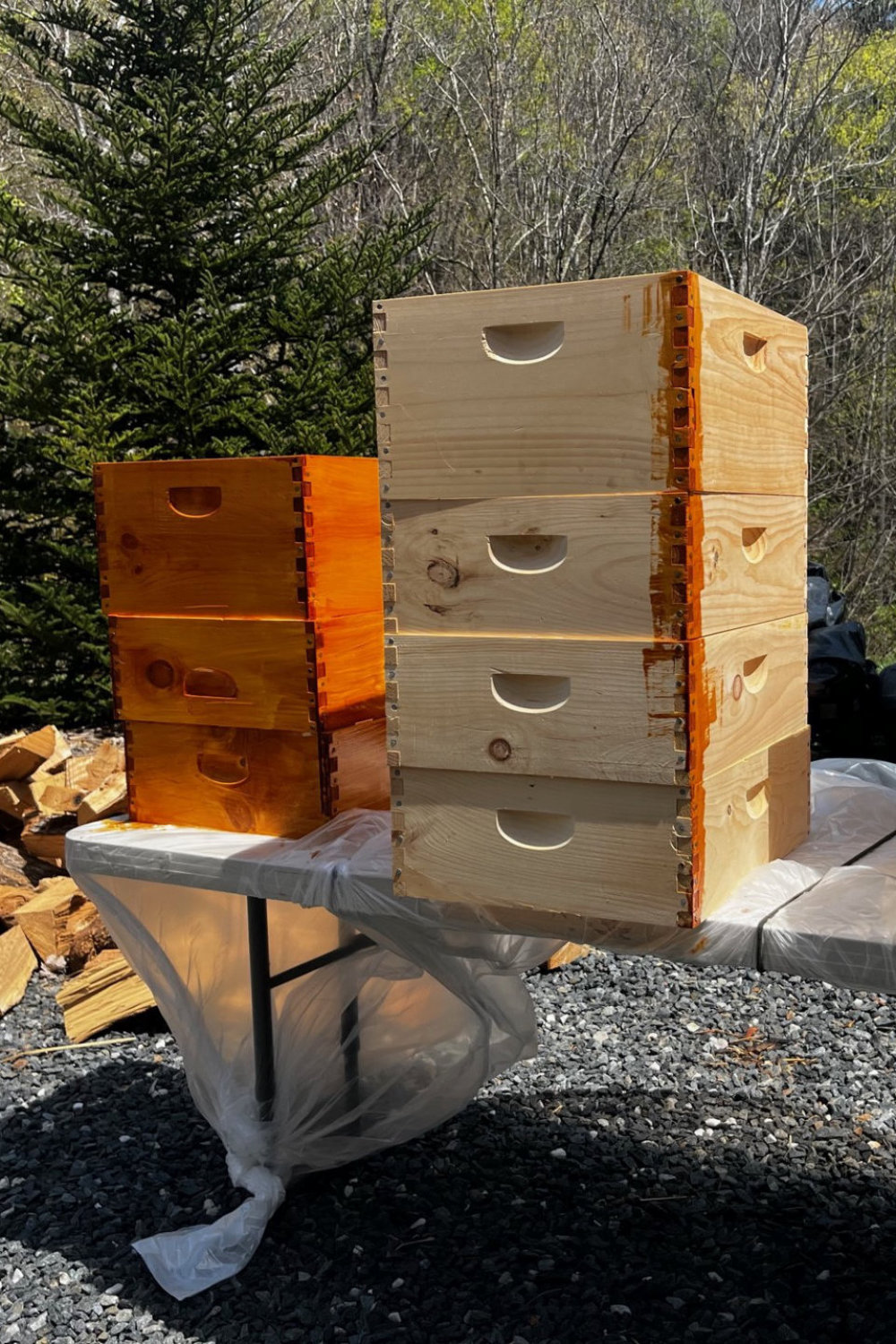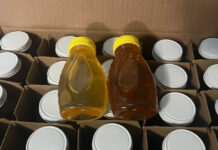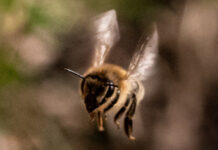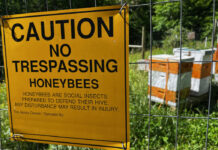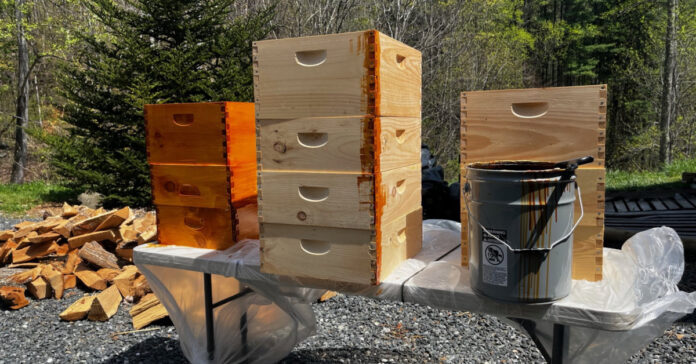
Although I am up to seven beehives, I think my bees were in better shape in late February than they are in Mid-April. It’s been a rough six weeks.
As you may recall, I started winter with six hives. All six lived through the winter and were growing robustly thanks to a warmer-than-usual February. Then a wave of cold swept across the country in March and killed one hive, leaving thousands of dead bees. I cleaned out the hive and made a split on-the-spot to repopulate that hive. Later, I made a second split to reduce the population in my stronger hives and reduce the chance of a swarm.
The warm February followed by the cold March has not only been hard on the bees, it’s been hard on the plants they count on for pollen and nectar. This pattern seems to be coming to an end as the local apple trees are blooming. The blackberries have tiny leaves but are not yet close to blooming. I think of their blossoms as the start of the spring nectar flow. That’s when I will put on the honey supers.
Making matters even worse, I’ve been stung more this year than I was all of last year, and it’s not even May. This includes one pesky bee who made its way inside my pants leg and stung me right below the knee. During the brief excitement leading up to that sting, you might have thought I was dancing the Highland Fling.
Queenless Hives
Three of my hives are queenless and one has queen problems. Only two of the three are queenless on purpose. These are because of the recent splits, and I gave them resources to make their own queens. That appears to be well underway, and at least the queen may even have hatched already. Now they just have to have a successful mating flight. If I see eggs and young brood in the hives in 10 to 14 days, I’ll know they are in good shape, my splits were successful, and the queen survived her mating flight and returned to the hive. I’m crossing my fingers.
One of the older hives has no queen which is a mystery. (I guess they could have swarmed, but I saw no sign of that.) The queen seems to have disappeared, which is a shame because it was a very strong hive last year. When I opened it up this past Sunday and there was no young brood anywhere. I transferred two frames of young brood and eggs into the hive and will just have to hope they make an emergency queen. I’ll add some more resources from a stronger hive to help keep it going.
The only good thing about no brood is the hives are being given a brood break, which reduces mites. When we reach a state where there is no capped brood, I’ll dose the hive with oxalic acid vapor, which kills varroa that is not in capped brood.
A Problem Queen
A fourth hive is an even greater mystery. When I was inspecting it on Sunday, there was no brood in the top box. This is unusual since the queens usually like to move upwards. I started inspecting the bottom box and there was no recent brood. There was plenty of food and a few dry queen cups. I was thinking I had a second missing queen, but then I found her on the second-to-last frame. She looked fine, but she apparently wasn’t laying much, if at all.
I’d like to retire her (a polite way of saying kill her) and replace her with a new queen, but the weather around here has been so topsy-turvy that none of our local queen providers have queens available. They are using what few they have in their own hives and to populate nucs for sale. I’ll just have to hope that one of my other hives produces some queen cells I can move over.
A Learning Year
To summarize, in mid to late April, I have two new splits, two very robust hives, two in rough shape and one that seems to mosey along just fine, neither too strong nor too weak. We’re still as much as a month away from the main honey flow. I am hoping that all of my hives will be stronger and ready to bring in a good crop by then, but it will be interesting to see if I produce more honey than last year.
This looks like a learning year, one that will make me a better beekeeper in the future. My biggest lesson is to not move frames indiscriminately between hives until I have located and caged the queen. I know this has caused at least one problem, and possibly two.
My second lesson is I now see firsthand why many commercial beekeepers choose to re-queen their hives each year. The hives I have with queen troubles are both from 2021 and the queens are old and may be going through the honeybee equivalent of menopause. When left to their own devices, bees are supposed to notice when the queen is slowing down and replace her with a fresh queen, through a process known as supersedure. I’m not sure why that hasn’t happened here. In any case, it’s enough to make me want to replace my 2022 queens in late 2023, so I go into 2024 with hives full of 2023 queens.
Re-queening in the late summer or fall is reportedly responsible for explosive hive growth the following spring.
Laissez-faire Beekeeping
I spent a day helping a local beekeeper who is far more experienced than I and breeds and sells queen bees. It was a good day in the bee yard and a reminder not to get too worked up about a missing queen. Working there reminded me that, in most cases, hives replace their own queens. This happened to me two years ago when I lost a queen in late summer. I did nothing, and four weeks later, the hive had a queen again. Chances are, this is already underway in my one queenless hive.
It’s been said that if you ask ten beekeepers the same question, you will get 12 different answers. Simply put, there are many ways to do something and they may all work, even if some work better or more often. I know persnickety beekeepers who replace every frame in the exact same place facing the same direction. I don’t, and it seems to work for me. My bet is those folks who put their frames back in exactly the same place find it works for them.
Still, working with this more experienced beekeeper who has a much more laissez-faire attitude was a welcome reminder that bees have been doing just fine when they lived in hollow trees and had to contend with bears and other predators. As long as we beekeepers control the mites and leave them sufficient honey to get them through the winter, the bees should be able to take care of themselves 90 percent of the time. Sure, active hive management can boost honey production, but dialing back and worrying less may make beekeeping more fun. Right now, this isn’t something my livelihood depends on, so I should enjoy it while I can.
Warm Weather
We have been taking advantage of a spate of warm weather. Those garden plants that can be direct-seeded into the raised beds have been planted. We are now in the water-and-wait period where we wait to see the first green shoots. (The other challenge is keeping the chickens out of there when they are free ranging.) Meanwhile, the eight varieties we started indoors continue to do well. Some of them will get hardened off and go into the garden soon; the most cold-sensitive will wait another month.
I also painted ten new bee boxes, which I had built this past winter. I have enough bottom boards and lids to have ten hives. Unfortunately, I don’t quite have enough full-size hive bodies to have ten double-deep hives. I am thinking of buying five more. Then again, I can save a few dollars per hive body if I buy ten at a time. That would give me sufficient hive bodies for 12 or 13 double deeps. I’m not sure I need that many. I’m even less sure if I want that many.
Oh, who am I kidding? I’ll probably get all ten.
